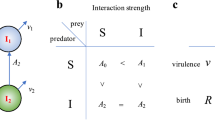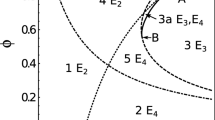Abstract
Food web structure of free-living species is an important determinant of parasite species richness. Downwardly asymmetric predator–prey interactions (where there are more prey than predator species) have been shown, both theoretically and empirically, to harbour more trophically transmitted parasite species than expected due to chance. Here, we demonstrate that this could be due to the increase in the basic reproductive ratio that the addition of non-host prey species to a system creates. However, we note that the basic reproductive ratio is only increased by those prey that stabilise oscillations in a predator–prey system, and is decreased by those that do not.





Similar content being viewed by others
References
Anderson, R. M., & May, R. M. (1979). Population biology of infectious disease: Part I. Nature, 280, 361–367.
Anderson, T. K., & Sukhdeo, M. V. (2011). Host centrality in food web networks determines parasite diversity. PLoS ONE, 6, 1–9.
Bacaër, N. (2007). Approximation of the basic reproductive number r 0 for vector-borne diseases with a periodic vector population. Bull. Math. Biol., 69, 1067–1091.
Bacaër, N. (2009). Periodic matrix population models: growth rate, basic reproductive number and entropy. Bull. Math. Biol., 71, 1781–1792.
Bacaër, N., & Dads, E. H. A. (2012). On the biological interpretation of a definition for the parameter r 0 in periodic population models. J. Math. Biol., 65, 601–621.
Bacaër, N., & Guernaoui, S. (2006). The epidemic threshold of vector-borne diseases with seasonality: the case of cutaneous leishmaniasis in Chichaoua, Morocco. J. Math. Biol., 53, 421–436.
Bacaër, N., & Ouifki, R. (2007). Growth rate and basic reproduction number for population models with a simple periodic factor. Math. Biosci., 210, 647–658.
Bate, A. M., & Hilker, F. M. (2013). Predator-prey oscillations can shift when diseases become endemic. J. Theor. Biol., 316, 1–8.
Chattopadhyay, J., & Arino, O. (1999). A predator-prey model with disease in the prey. Nonlinear Anal., 36, 747–766.
Chen, H.-W., Liu, W.-C., Davis, A. J., Jordán, F., Hwang, M.-J., & Shao, K.-T. (2008). Network position of hosts in food webs and their parasite diversity. Oikos, 117, 1847–1855.
Choisy, M., Brown, S. P., Lafferty, K. D., & Thomas, F. (2003). Evolution of trophic transmission in parasites: why add intermediate hosts? Am. Nat., 162(2), 172–181.
Comins, H., & Hassell, M. (1976). Predation in multi-prey communities. J. Theor. Biol., 62, 93–117.
Dambacher, J. M., Li, H. W., & Rossignol, P. A. (2002). Relevance of community structure in assessing indeterminancy of ecological predictions. Ecology, 83(5), 1372–1385.
Davis, S., Trapman, P., Leirs, H., Begon, M., & Heesterbeek, J. (2008). The abundance threshold for plague as a critical percolation phenomenon. Nature, 454, 634–637.
Diekmann, O., Heesterbeek, J., & Metz, J. (1990). On the definition and the computation of the basic reproductive ratio R 0 in models for infectious diseases in heterogeneous populations. J. Math. Biol., 28, 365–382.
Diekmann, O., Heesterbeek, J., & Roberts, M. (2010). The construction of next-generation matrices for compartmental epidemic models. J. R. Soc. Interface, 7, 873–885.
Dobson, A. (1988). The population biology of parasite-induced changes in host behaviour. Q. Rev. Biol., 63(2), 139–165.
Ferguson, S. H., Kingsley, M. C., & Higdon, J. W. (2012). Killer whale (Orcinus orca) predation in a multi-prey system. Popul. Ecol., 54, 31–41.
Gibson, G. A., Musgrave, D. L., & Hinckley, S. (2005). Non-linear dynamics of a pelagic ecosystem model with multiple predator and prey types. J. Plankton Res., 27(5), 427–447.
Greenman, J., & Pasour, V. (2012). Threshold dynamics for periodically forced ecological systems: the control of population invasion and exclusion. J. Theor. Biol., 295, 154–167.
Hadeler, K., & Freedman, H. (1989). Predator-prey populations with parasitic infection. J. Math. Biol., 27, 609–631.
Heesterbeek, J. (2002). A brief history of r 0 and a recipe for its calculation. Acta Biotheor., 50, 189–204.
Heesterbeek, J., & Roberts, M. (1995). Threshold quantities for helminth infections. J. Math. Biol., 33, 415–434.
Holt, R., & Lawton, J. (1994). The ecological consequences of shared natural enemies. Annu. Rev. Ecol. Evol. Syst., 25, 495–520.
Hsieh, Y.-H., & Hsiao, C.-K. (2008). Predator-prey model with disease infection in both populations. Math. Med. Biol., 25, 247–266.
Inouye, R. S. (1980). Stabilization of a predator-prey equilibrium by the addition of a second “keystone” victim. Am. Nat., 115(2), 300–305.
Lafferty, K. D. (1999). The evolution of trophic transmission. Parasitol. Today, 15(3), 111–115.
Lafferty, K. D., & Morris, A. K. (1996). Altered behaviour of parasitized killifish increases susceptibility to predation by bird final hosts. Ecology, 77, 1390–1397.
Marcogliese, D. (2002). Food webs and the transmission of parasites to marine fish. Parasitology, 124, S83–S99.
Matsuda, H., Hori, M., & Abrams, P. A. (1996). Effects of predator-specific defence on biodiversity and community complexity in two-trophic-level communities. Evol. Ecol., 10, 13–28.
Maynard Smith, J., & Slatkin, M. (1971). The stability of predator-prey systems. Ecology, 54(2), 384–391.
McLellan, B. N., Serrouya, R., Wittmer, H. U., & Boutin, S. (2010). Predator-mediated Allee effects in multi-prey systems. Ecology, 91(1), 286–292.
Ostfeld, R. S., & Keesing, F. (2012). Effects of host diversity on infectious disease. Annu. Rev. Ecol. Evol. Syst., 43, 157–182.
Paterson, R. A., Townsend, C. R., Tompkins, D. M., & Poulin, R. (2012). Ecological determinants of parastie acquisition by exotic fish species. Oikos, 121, 1889–1895.
Poulin, R., & Leung, T. (2011). Body size, trophic level, and the use of fish as transmission routes by parasites. Oecologia, 166, 731–738.
Randhawa, H. S., & Poulin, R. (2010). Determinants of tapeworm species richness in elasmobranch fishes: untangling environmental and phylogenetic influences. Ecography, 33, 866–877.
Rebelo, C., Margheri, A., & Bacaër, N. (2012). Persistence in seasonally forced epidemiological models. J. Math. Biol., 64, 933–949.
Rossiter, W., & Sukhdeo, M. V. K. (2011). Exploitation of asymmetric predator-prey interactions by trophically transmitted parasites. Oikos, 120, 607–614.
Salkeld, D. J., Salathé, M., Stapp, P., & Holland Jones, J. (2010). Plague outbreaks in prairie dog populations explained by percolation thresholds of alternative host abundance. Proc. Natl. Acad. Sci. USA, 107(32), 14247–14250.
van den Driessche, P., & Watmough, J. (2002). Reproduction numbers and sub-threshold endemic equilibria for compartmental models of disease transmission. Math. Biosci., 180, 29–48.
van Leeuwen, E., Jansen, V., & Bright, P. (2007). How population dynamics shape the functional response in a one-predator-two-prey system. Ecology, 88(6), 1571–1581.
Wang, W., & Zhao, X.-Q. (2008). Threshold dynamics for compartmental epidemic models in periodic environments. J. Dyn. Differ. Equ., 20, 699–717.
Zhang, T., Liu, J., & Teng, Z. (2008). Differential susceptability time-dependent SIR epidemic model. Int. J. Biomath., 1(1), 45–64.
Acknowledgements
The authors would like to thank the referees for their careful work and useful and perceptive comments, which have very much improved the paper. C.F. McQuaid is a Commonwealth Scholar, funded by the Department for International Development, UK.
Author information
Authors and Affiliations
Corresponding author
Rights and permissions
About this article
Cite this article
McQuaid, C.F., Britton, N.F. Trophic Structure, Stability, and Parasite Persistence Threshold in Food Webs. Bull Math Biol 75, 2196–2207 (2013). https://doi.org/10.1007/s11538-013-9887-5
Received:
Accepted:
Published:
Issue Date:
DOI: https://doi.org/10.1007/s11538-013-9887-5




